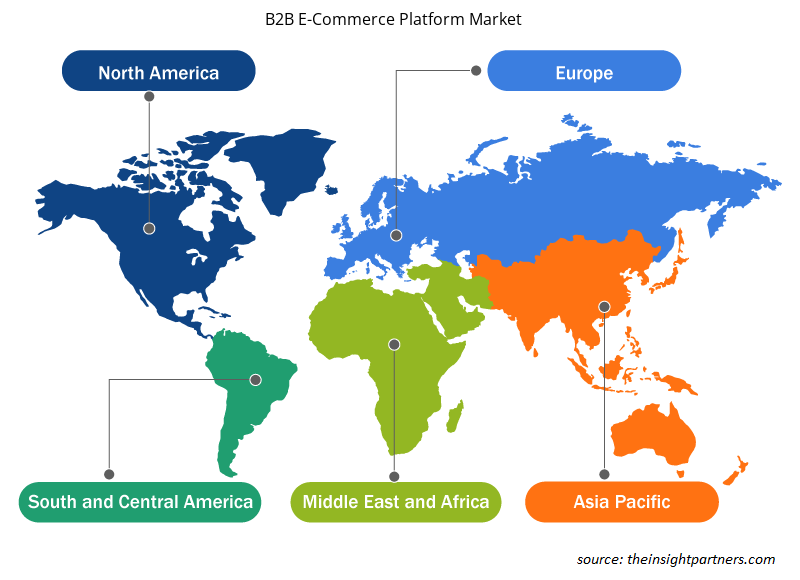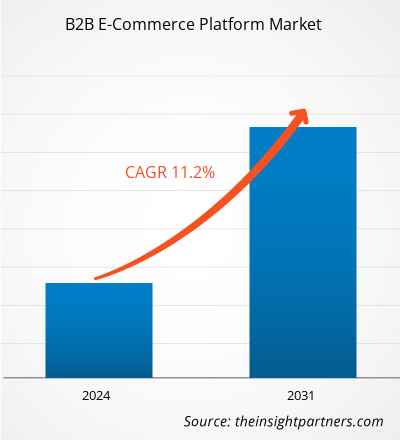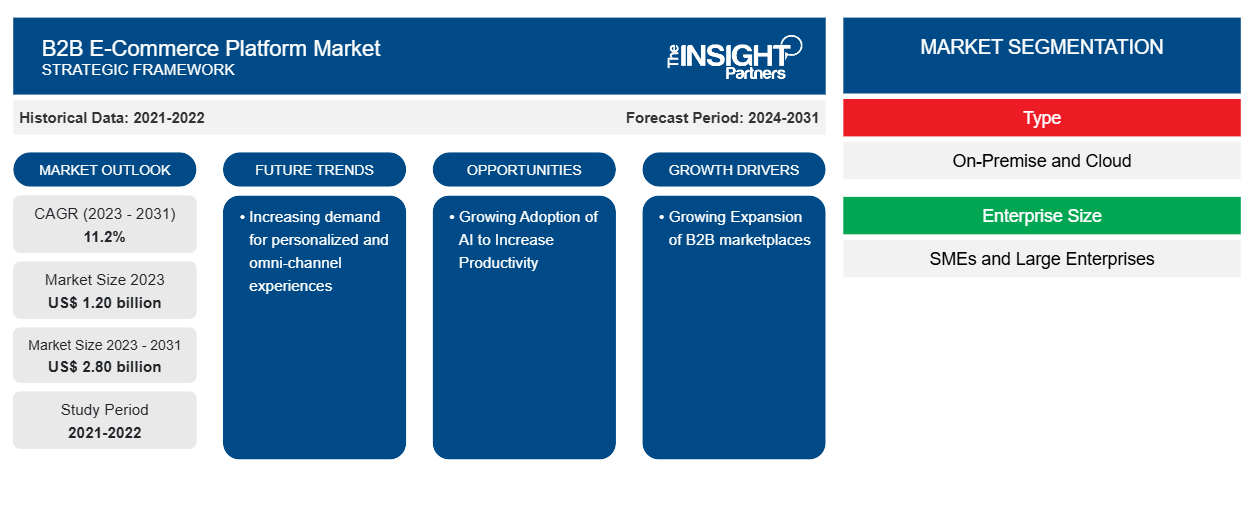Si prevede che la dimensione del mercato delle piattaforme di e-commerce B2B raggiungerà i 2,80 miliardi di dollari entro il 2031, rispetto agli 1,20 miliardi di dollari del 2023. Si prevede che il mercato registrerà un CAGR dell'11,2% nel 2023-2031. È probabile che la crescente domanda di esperienze personalizzate e omnicanale rimanga una tendenza chiave del mercato delle piattaforme di e-commerce B2B.
Analisi di mercato della piattaforma di commercio elettronico B2B
Le tecnologie digitali vengono utilizzate da molte aziende per migliorare l'esperienza del cliente, aumentare l'efficienza e automatizzare i processi. Il business online sta diventando più facile per le aziende grazie all'adozione diffusa degli smartphone e allo sviluppo continuo di reti Internet ad alta velocità. Di conseguenza, sono disponibili più piattaforme di e-commerce B2B, che offrono alle aziende un modo semplice ed efficace per comunicare con clienti e partner. Allo stesso tempo, la globalizzazione in corso consente alle aziende di condurre e-commerce B2B con clienti e fornitori in tutto il mondo, stimolando così il commercio internazionale.
Panoramica del mercato delle piattaforme di e-commerce B2B
Il commercio B2B (business-to-business) è lo scambio di beni, servizi o informazioni tra aziende piuttosto che da azienda a consumatore (B2C). Una transazione B2B avviene tra due aziende, come un rivenditore online e un grossista. La diffusione della pandemia è stato uno dei principali fattori che hanno alimentato la crescita del mercato negli ultimi anni, poiché la maggior parte delle aziende deve seguire varie restrizioni. Inoltre, un numero crescente di millennial che entrano nello spazio B2B sta anche stimolando la crescita del mercato delle piattaforme di e-commerce B2B.
Personalizza questo report in base alle tue esigenze
Riceverai la personalizzazione gratuita di qualsiasi report, comprese parti di questo report, o analisi a livello nazionale, pacchetto dati Excel, oltre a usufruire di grandi offerte e sconti per start-up e università
- Scopri le principali tendenze di mercato in questo rapporto.Questo campione GRATUITO includerà analisi di dati che spaziano dalle tendenze di mercato alle stime e alle previsioni.
Driver di mercato e opportunità della piattaforma di e-commerce B2B
Crescente espansione dei mercati B2B
I venditori B2B utilizzano piattaforme di eCommerce di terze parti per ampliare la propria portata, valutare la concorrenza e offrire comodità agli acquirenti che utilizzano marketplace come Amazon Business e Alibaba.com per effettuare acquisti. I marketplace B2B forniscono agli acquirenti risorse come shopping comparativo, valutazioni dei clienti e recensioni di prodotti. Per questo motivo, secondo Google, oltre l'80% degli acquirenti B2B preferisce ordinare o effettuare pagamenti tramite canali di commercio digitale. Quindi, la crescente espansione dei marketplace B2B sta alimentando la crescita del mercato delle piattaforme di e-commerce B2B.Alibaba.com to make purchases. B2B marketplaces provide buyers with resources such as comparative shopping, customer ratings, and product reviews. For this reason, according to Google, more than 80% of B2B buyers prefer to order or make payments through digital commerce channels. Hence, the growing expansion of B2B marketplaces is fueling the growth of the B2B E-Commerce Platform Market.
Crescente adozione dell'intelligenza artificiale per aumentare la produttività
Secondo Salesforce, Inc., il 32% delle aziende B2B ha integrato completamente l'IA, mentre quasi la metà (45%) è ancora in fase di sperimentazione. Le aziende hanno già notato significativi guadagni nella produttività dei dipendenti e nell'efficacia operativa. Inoltre, l'IA ha la capacità di migliorare notevolmente aree precedentemente problematiche della trasformazione digitale B2B. L'IA ha il potenziale per ridurre significativamente la quantità di lavoro manuale richiesta per queste attività. Con l'IA generativa, le aziende possono ora mostrare una parte maggiore del loro inventario in formato digitale e molte saranno in grado di espandersi in materiale di prodotto ancora più complesso, come esperienze di acquisto visive. Pertanto, si prevede che la crescente adozione dell'IA creerà un'opportunità per la crescita del mercato delle piattaforme di e-commerce B2B nel periodo previsto.forecasted period.
Analisi della segmentazione del rapporto di mercato della piattaforma di commercio elettronico B2B
I segmenti chiave che hanno contribuito alla derivazione dell'analisi di mercato della piattaforma di e-commerce B2B sono tipologia, dimensioni aziendali e settore dell'utente finale.
- In base al tipo, il mercato delle piattaforme di e-commerce B2B è segmentato in on-premise e cloud. Il segmento on-premise ha detenuto una quota di mercato maggiore nel 2023.
- In base alle dimensioni dell'impresa, il mercato è segmentato in PMI e grandi imprese. Il segmento delle grandi imprese ha detenuto una quota di mercato maggiore nel 2023.
- In base al settore dell'utente finale, il mercato è segmentato in automotive , electricals & electronics, general industries e altri. Si prevede che il segmento automotive registrerà una crescita significativa nel periodo previsto.
Analisi della quota di mercato della piattaforma di e-commerce B2B per area geografica
L'ambito geografico del rapporto sul mercato delle piattaforme di e-commerce B2B è suddiviso principalmente in cinque regioni:Nord America, Asia Pacifico, Europa, Medio Oriente e Africa e Sud America/Sud e Centro America.
Si prevede che l'Asia Pacifica assisterà a una crescita significativa nel mercato delle piattaforme di e-commerce B2B. Il mercato in questa regione è segmentato in Australia, Cina, India, Giappone, Corea del Sud e il resto dell'APAC. L'industrializzazione e l'urbanizzazione in espansione della regione, in particolare in Cina, Giappone e India, probabilmente stimoleranno l'espansione del mercato. Inoltre, secondo l'International Air Transport Association (IATA), l'APAC guida la crescita del mercato dell'e-commerce a livello globale, con la Cina che rappresenta una percentuale significativa della crescita. Secondo l'International Trade Administration, il mercato dell'e-commerce della Cina è il più grande al mondo e genera quasi il 50% delle transazioni mondiali. Inoltre, secondo l'India Brand Equity Foundation (IBEF), si prevede che il mercato dell'e-commerce in India raggiungerà i 188 miliardi di dollari entro il 2025. Pertanto, il crescente settore dell'e-commerce nella regione sta alimentando la crescita del mercato delle piattaforme di e-commerce B2B.
Approfondimenti regionali sul mercato delle piattaforme di e-commerce B2B
Le tendenze regionali e i fattori che influenzano il mercato delle piattaforme di e-commerce B2B durante il periodo di previsione sono stati ampiamente spiegati dagli analisti di Insight Partners. Questa sezione discute anche i segmenti e la geografia del mercato delle piattaforme di e-commerce B2B in Nord America, Europa, Asia Pacifico, Medio Oriente e Africa e America centrale e meridionale.

- Ottieni i dati specifici regionali per il mercato delle piattaforme di e-commerce B2B
Ambito del rapporto di mercato sulla piattaforma di commercio elettronico B2B
| Attributo del report | Dettagli |
|---|---|
| Dimensioni del mercato nel 2023 | 1,20 miliardi di dollari USA |
| Dimensioni del mercato entro il 2031 | 2,80 miliardi di dollari USA |
| CAGR globale (2023-2031) | 11,2% |
| Dati storici | 2021-2022 |
| Periodo di previsione | 2024-2031 |
| Segmenti coperti | Per tipo
|
| Regioni e Paesi coperti | America del Nord
|
| Leader di mercato e profili aziendali chiave |
|
Densità degli attori del mercato: comprendere il suo impatto sulle dinamiche aziendali
Il mercato delle piattaforme di e-commerce B2B sta crescendo rapidamente, spinto dalla crescente domanda degli utenti finali dovuta a fattori quali l'evoluzione delle preferenze dei consumatori, i progressi tecnologici e una maggiore consapevolezza dei vantaggi del prodotto. Con l'aumento della domanda, le aziende stanno ampliando le loro offerte, innovando per soddisfare le esigenze dei consumatori e capitalizzando sulle tendenze emergenti, il che alimenta ulteriormente la crescita del mercato.
La densità degli operatori di mercato si riferisce alla distribuzione di aziende o società che operano in un particolare mercato o settore. Indica quanti concorrenti (operatori di mercato) sono presenti in un dato spazio di mercato in relazione alle sue dimensioni o al valore di mercato totale.
Le principali aziende che operano nel mercato delle piattaforme di e-commerce B2B sono:
- Società Apttus
- Società a responsabilità limitata
- Alibaba
- Commercio Kibo
- Magneto IT Solutions Pvt. Ltd
- Soluzioni su richiesta Ltd.
Disclaimer : le aziende elencate sopra non sono classificate secondo un ordine particolare.

- Ottieni una panoramica dei principali attori del mercato delle piattaforme di e-commerce B2B
Notizie di mercato e sviluppi recenti della piattaforma di e-commerce B2B
Il mercato delle piattaforme di e-commerce B2B viene valutato raccogliendo dati qualitativi e quantitativi dopo la ricerca primaria e secondaria, che include importanti pubblicazioni aziendali, dati associativi e database. Di seguito è riportato un elenco degli sviluppi nel mercato:
- Schaeffler India Limited, una sussidiaria di Schaeffler AG, ha firmato un accordo di acquisto di azioni per acquisire il 100 percento delle azioni di KRSV Innovative Auto Solutions Private Limited ("KRSV" di seguito). KRSV ha sede a Bengaluru e offre soluzioni di riparazione alle officine aftermarket indiane tramite la sua piattaforma di e-commerce B2B in rapida crescita, Koovers. Koovers è un'aggiunta ideale alle attività di Schaeffler Automotive Aftermarket in India. (Fonte: Schaeffler, comunicato stampa, 2023)
- BigCommerce, una piattaforma e-commerce Open SaaS leader per marchi B2C e B2B affermati e in rapida crescita, ha annunciato l'acquisizione di BundleB2B, un partner tecnologico di lunga data di BigCommerce che fornisce funzionalità B2B di livello successivo per i commercianti BigCommerce. (Fonte: Intertek, comunicato stampa, 2021)
Copertura e risultati del rapporto di mercato sulla piattaforma di e-commerce B2B
Il rapporto "Dimensioni e previsioni del mercato della piattaforma di e-commerce B2B (2021-2031)" fornisce un'analisi dettagliata del mercato che copre le seguenti aree:
- Dimensioni e previsioni del mercato a livello globale, regionale e nazionale per tutti i segmenti di mercato chiave coperti dall'ambito
- Dinamiche di mercato come fattori trainanti, vincoli e opportunità chiave
- Principali tendenze future
- Analisi dettagliata delle cinque forze PEST/Porter e SWOT
- Analisi di mercato globale e regionale che copre le principali tendenze di mercato, i principali attori, le normative e gli sviluppi recenti del mercato
- Analisi del panorama industriale e della concorrenza che copre la concentrazione del mercato, l'analisi della mappa di calore, i principali attori e gli sviluppi recenti
- Profili aziendali dettagliati
- Analisi storica (2 anni), anno base, previsione (7 anni) con CAGR
- Analisi PEST e SWOT
- Valore/volume delle dimensioni del mercato - Globale, Regionale, Nazionale
- Industria e panorama competitivo
- Set di dati Excel
Report recenti
Testimonianze
Motivo dell'acquisto
- Processo decisionale informato
- Comprensione delle dinamiche di mercato
- Analisi competitiva
- Analisi dei clienti
- Previsioni di mercato
- Mitigazione del rischio
- Pianificazione strategica
- Giustificazione degli investimenti
- Identificazione dei mercati emergenti
- Miglioramento delle strategie di marketing
- Aumento dell'efficienza operativa
- Allineamento alle tendenze normative





















 Ottieni un campione gratuito per - Mercato delle piattaforme di e-commerce B2B
Ottieni un campione gratuito per - Mercato delle piattaforme di e-commerce B2B